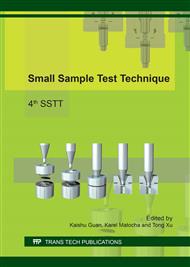[1]
Sun Biao. Development and application of micro damage testing technology for the power plant's metal. China Measurement & Testing Technology. 2016, 42(5): 11-17. (in Chinese).
Google Scholar
[2]
Kurumlu. D, Payton E.J. Young M.L., et al. High-temperature strength and damage evolution in short fiber reinforced aluminum alloys studied by miniature creep testing and synchrotron microtomography[J]. Acta Materialia, 2012, 60: 67-78.
DOI: 10.1016/j.actamat.2011.09.022
Google Scholar
[3]
Kumar Kundan, Pooleery Arun, Madhusoodanan K, et al. Use of Miniature Tensile Specimen for Measurement of Mechanical Properties[C]. 1st International Conference on Structural Integrity, ICONS-2014, 2014, 86: 899-909.
DOI: 10.1016/j.proeng.2014.11.112
Google Scholar
[4]
Dogan Bilal. Sampling and Small Punch Testing in the Power Generation Industry[C]. The 1st Int. Conf. SSTT: Determination of Mechanical Properties of Materials By Small Punch and Other Miniature Testing Techniques. (2010).
DOI: 10.1115/pvp2011-57048
Google Scholar
[5]
Krompholz Klaus, Kalkhof Dietmar. Size effect studies of the creep behavior of a pressure vessel steel at temperatures from 700 to 900 ℃[J]. Journal of Nuclear Materials, 2002, 305: 112-123.
DOI: 10.1016/s0022-3115(02)01029-2
Google Scholar
[6]
TAKADA Akio,SAKANE Masao. Miniature Creep Testing for Sn-37Pb and Sn-3. 5Ag Soider. 2005 ASME International Mechanical Engineering Congress and Exposition, (2005).
DOI: 10.1115/imece2005-80532
Google Scholar
[7]
Olbricht Jurgen, Bismarck Marc, Skrotzki Birgit. Characterization of the creep properties of heat resistant 9-12 chromium steels by miniature specimen testing [J]. Materials Science & Engineering A, 2013, 585:335-342.
DOI: 10.1016/j.msea.2013.07.067
Google Scholar
[8]
Klevtsov Ivan, Dedov Andrei. DETERMINATION OF TENSILE PROPERTIES OF POWER PLANT STEELS BY TESTING OF MINIATURE SPECIMENS[C]. Proceedings of the ASME 2013 Pressure Vessels and Piping Conference PVP2013, 2013: 1-5.
DOI: 10.1115/pvp2013-97135
Google Scholar
[9]
Wang Xiao wei, Gong Jian ming, Guo xiao feng, et al. Creep properties and fracture mechanism of P92 steel used in ultra-supercritical power plant. Journal of Nanjing tech university, 2014, 36 (3): 32-38. (in Chinese).
Google Scholar
[10]
Chen Yun xiang, Yan Wei, Hu Ping, et al. CDM MODELING OF CREEP BEHAVIOR OF T/P91 STEEL UNDER HIGH STRESSES. ACTA METALLURGICA SINICA, 2011: 1372-1377. (in Chinese).
Google Scholar
[11]
Dobes F, Cadek J. The Apparent Internal Stress in Creep of Alloys Strengthened by Coherent Particles With Long Range Ordered Structure[J]. Materials Science and Engineering, 1976, 24(2): 287.
DOI: 10.1016/0025-5416(76)90122-1
Google Scholar
[12]
Kachanov L M. On the Kinetics of Crack Growth[J]. Journal of Applied Mathematics and Mechanics. 1961, 25(3): 739.
Google Scholar
[13]
Rabotnov Y N. Creep Problems in Structural Members[M]. Amsterdam: North Holland Pub1 Co, (1969).
Google Scholar
[14]
Wilshire B., Burt H. Damage Evolution During Creep of Steels[J]. International Journal of Pressure Vessels and Piping, 2008, 88(1-2): 47.
DOI: 10.1016/j.ijpvp.2007.06.002
Google Scholar


